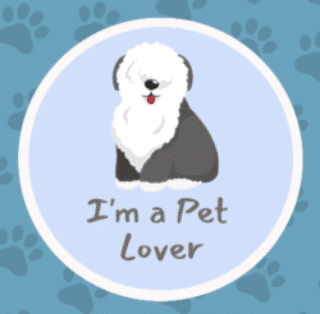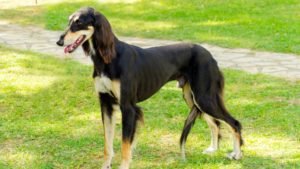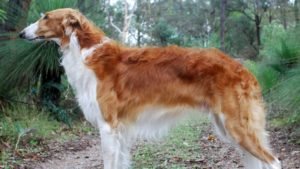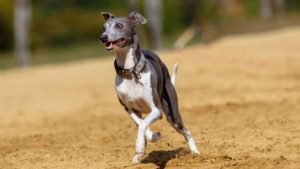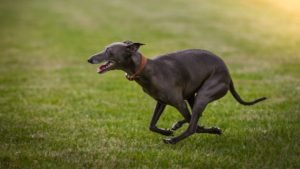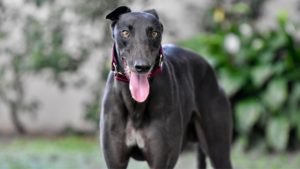Irish Wolfhound History
If the history of dogs were laid out as a tapestry, the Irish Wolfhound would undoubtedly occupy a venerable place in its weave. Originating in Ireland, as the name aptly indicates, these majestic canines were initially used for hunting large game like wolves and elk. Their original name in Irish was “Cu Faoil,” which translates to “hound of the wolves.” Even as far back as 391 A.D., their reputation had reached Roman territory, meriting mentions in Roman records.
Irish Wolfhounds don’t just have a hunting role. In medieval Ireland, they were considered a symbol of nobility and were often used as gifts for royal families and influential figures. Yet, the depletion of wolves in Ireland led to a decline in the breed, nearly pushing it to the brink of extinction. Thankfully, Captain George Augustus Graham undertook the arduous task of reviving the species in the late 19th century. Through his painstaking efforts, which included cross-breeding with other large breeds like the Tibetan Mastiff and Great Dane, we have the Irish Wolfhound we know today.
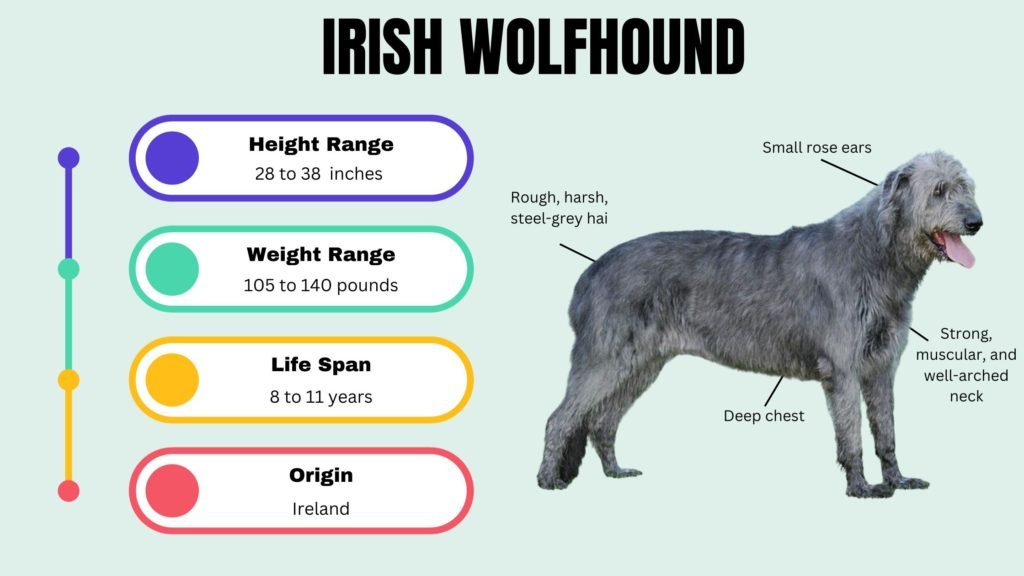
Irish Wolfhound Characteristics
“Beauty lies in the eyes of the beholder,” goes the saying, but you’d be hard-pressed to find anyone who doesn’t appreciate the majestic form of the Irish Wolfhound. Standing at least 30 inches at the shoulder, these dogs are the epitome of grandeur. Yet, their physical attributes are more than skin-deep. They possess a rough, wiry coat, which can come in various colors, including gray, black, red, and brindle. The skin is an adaptation to the harsh climates they were bred to work in, providing them protection against the elements.
Despite their massive size, weighing around 140 pounds on average, they are incredibly agile and can cover ground with an effortless gait. It is crucial because these are not mere lap dogs; they require plenty of space and exercise. Irish Wolfhounds need open spaces to thrive and stretch their long legs, making apartment life unsuitable.
Personality
However, an Irish Wolfhound’s most endearing feature lies in its personality. Contrary to what their imposing figure might suggest, these dogs are quintessentially gentle giants. They are known for their calm disposition and keen intelligence, forming deep bonds with their human families. The old Irish saying “Gentle when stroked, fierce when provoked” aptly sums up their demeanor.
Their social nature makes them great family dogs, capable of forming bonds with humans and other pets, including smaller animals. While you might think their size would make them excellent guard dogs, they are more prone to greet strangers with a wagging tail rather than a menacing growl.
In terms of training, their keen intelligence and eagerness to please make them relatively easy to train, even for first-time dog owners. However, their training should be started early, mainly because, given their large size, behavioral issues can be magnified. They are sensitive dogs that respond well to positive reinforcement techniques.
Irish Wolfhounds also require a fair amount of exercise to keep their minds and bodies active. Long walks and runs are ideal, but bear in mind that, given their size, overexertion can lead to joint issues. Like many large breeds, they are prone to specific health issues such as hip dysplasia and are known for a shorter lifespan, usually around 6-10 years, making every moment with them precious.
Irish Wolfhound Life Span
The life span of an Irish Wolfhound is generally shorter than many other breeds, often ranging between 8 and 12 years. This limited time makes preventative healthcare paramount. Frequent vet check-ups, mainly focusing on early detection of hereditary conditions like hip dysplasia and heart issues, can help extend your pet’s life. Interestingly, research suggests that, like larger mammals in the animal kingdom, these large breeds age more quickly but mature more slowly, so many consider their wolfhounds to be “puppies at heart” well into their adult years.
Irish Wolfhound Family Life
Irish Wolfhounds fit seamlessly into family life. They are remarkably gentle, especially with children, and their calm temperament makes them ideal for households of all sizes. Nonetheless, owners should always remember their large size. Their wagging tails can knock over a toddler or an object from a coffee table. Supervision during their interaction with young children or frail adults is a must. They are not just pets; they become family members, almost akin to a gentle, protective, and furry uncle or aunt.
Irish Wolfhound Habitat and Diet
Irish Wolfhounds are often considered dogs needing a sprawling countryside estate to roam around. However, they are adaptable to different living environments, including suburban areas, as long as they exercise enough. A small yard or a nearby park where they can have regular walks is sufficient for their needs. Their diet is critical for maintaining their health and well-being. A protein-rich and balanced diet is recommended to support their muscular bodies, while fiber, vitamins, and minerals are essential for overall health. As with all large breeds, it’s crucial to carefully manage their caloric intake to prevent obesity, which can lead to serious health problems.
Irish Wolfhound Temperament
One word to describe the temperament of an Irish Wolfhound is “dignified.” They embody a quiet and calm courage, rarely showing aggression. They’re not necessarily outgoing with strangers but are not standoffish either. Early socialization is essential for them to grow up into well-adjusted adults. These dogs become loyal companions who feel deeply, suffer in silence, and love unconditionally. Some owners say you can almost see a soul behind their eyes, especially when they fix their gaze on you.
Irish W+olfhound Behavior With Other Animals
Irish Wolfhounds generally coexist peacefully with other animals. Whether they’re around other dogs, cats, or even smaller pets, they usually maintain a demeanor of gentle curiosity rather than aggression. However, their hunting lineage might sometimes awaken a higher prey drive. That is more an exception than a rule and is managed with training and socialization. It’s not uncommon for Irish Wolfhounds to develop deep friendships with other pets in the household. Some even act maternally or paternally towards smaller animals, watching over them as though they were their pups.
Irish Wolfhound Coat Color and Grooming
Irish Wolfhounds sport various coat colors, including grey, brindle, red, black, and fawn. Their coats are rough and wiry, requiring regular grooming to keep them healthy and clean. Brushing at least once weekly is necessary to remove dead hair and prevent matting. Additionally, their coats can trap debris, so a thorough inspection is advisable, especially after outdoor activities. Despite their imposing size, they don’t shed as much as one might expect, which benefits those concerned with pet allergens. Trimming the hair around their eyes and ears is also advised for aesthetic and health reasons. It’s a good practice to include nail clipping in the grooming routine, as their nails can overgrow due to their large size.
Irish Wolfhound Health
As mentioned earlier, the life span of an Irish Wolfhound tends to be shorter, often due to health issues common to large breeds. One of the most concerning is hip dysplasia, a genetic condition that can severely affect the dog’s quality of life. Regular screenings can offer early intervention opportunities. Cardiac issues, like dilated cardiomyopathy, are another concern and should be monitored through annual vet check-ups. These dogs are also prone to bone cancer, specifically osteosarcoma, which often appears with little warning. Regular, moderate exercise can help manage their weight, reducing the risk of exacerbating these health conditions.
Irish Wolfhound Price
Irish Wolfhounds are undoubtedly an investment. Puppy prices can range from $1,500 to $3,000 depending on lineage and breeder reputation. This initial cost is just the tip of the iceberg. Their size mandates higher food consumption, not to mention specialized healthcare and possibly even custom-made items like beds or crates. Pet insurance for these giants is also pricier compared to smaller breeds. Consequently, prospective owners must be financially prepared for a long-term commitment.
Irish Wolfhound Trainability
Irish Wolfhounds are intelligent but possess a calm independence, which can sometimes be mistaken for stubbornness. Early socialization is vital, and they respond exceptionally well to positive reinforcement techniques. Yelling or harsh methods generally don’t work well with this sensitive breed. Training should start early because a full-grown, untrained Irish Wolfhound can be a handful due to its size. Despite their large size, they’re surprisingly agile and can master commands and tricks if trained patiently.
Irish Wolfhound Care
Exercise is a crucial part of the primary care required for your pet. While this breed may demand less physical activity than others, providing them with a daily walk and the occasional free run in a secure area is essential. However, it’s important to note that their large frame makes them susceptible to joint issues and, therefore, avoid strenuous exercise like extended jogging. Moreover, their living space should be big enough to move around comfortably. They have a thick coat and are more sensitive to heat, so keeping them cool in the summer is essential. Lastly, it’s crucial to maintain a routine vet check-up schedule to monitor for early signs of any health issues that might arise later on.
